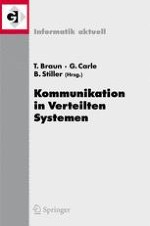2007 | Buch
Kommunikation in Verteilten Systemen (KiVS)
15. Fachtagung Kommunikation in Verteilten Systemen (KiVS 2007) Bern, Schweiz, 26. Februar – 2. März 2007
herausgegeben von: Torsten Braun, Georg Carle, Burkhard Stiller
Verlag: Springer Berlin Heidelberg
Buchreihe : Informatik aktuell
